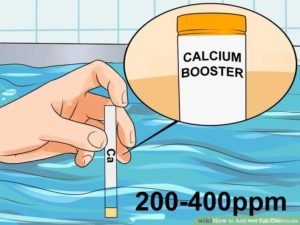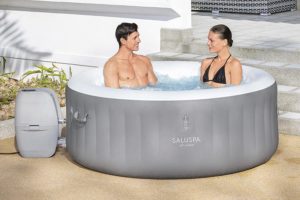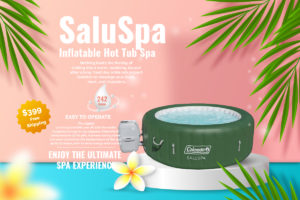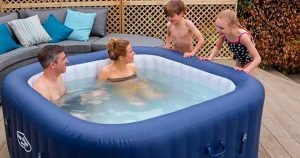Hot Tub Spa or Hot Tub Pool: Understanding Your Calcium Levels

Calcium is a naturally occurring mineral that is frequently found in high concentrations: this water is referred to as “hard” water. Calcium hardness is one of the important hot tub water chemistry constraints and its control is important to help assure healthy water quality. Calcium problems do not normally show a color to the hot tub pool water, unlike other metals such as iron and copper. The ideal range for hot tub spas is 80-200 PPM. Keep in mind that the calcium level may depend where you live and the type of hot tub pool water you are using. Low levels of calcium in your hot tub pool can lead to water conditions that will deteriorate the hot tub pool shell. There are chemicals that can raise the calcium hardness, as might be necessary for your hot tub. High calcium hardness levels, especially above 400 PPM, can lead to cloudy water problems and scum build up conditions in your hot tub pool. Various mineral treatment products for your hot tub are available to help deal with the problems associated with high calcium hardness levels. Hot tub spas calcium hardness levels can be determined by a simple water test. This is especially important with well water, as other problem causing minerals might be present and could require treatment.Hot tub magnetizers, also known as Magnetic Water Conditioners have been recognized to help reduce and eliminate scale formation in hot tub spas, by creating a positive electrical charge in the hot tub pool water passing through the return lines.
If you live in an area that tends to have soft water already, this isn’t as big of a threat as hard water conditions, but should not be ignored in hot tub spas. If you make sure that the pH and total alkalinity are always at the right level, the soft water may not be a big threat to your hot tub pool. However, soft water can add to the corrosiveness of the water and this can lead to damage of the hot tub spas shell. In addition, the soft water will support higher levels of foaming in your hot tub. Foam must, at least occasionally, be totally eliminated for good hot tub pool water sanitizing. To raise the calcium hardness, test for calcium hardness and then use a calcium hardness increaser, as directed.

There are two different types of calcium you can add to your hot tub pool water if the calcium level is too low. There is calcium that comes in liquid form and granular form. It does not matter which one you use for your hot tub spas since they both have the same affect on the water, however some people prefer the liquid form since it is easier to measure. But remember; always keep your hot tub pool water at a calcium level of 150-200 PPM.
It is advised to initially fill up your hot tub pool with soft water. This way it is easy for you to just add some calcium increaser to your hot tub spas. Try to avoid calcium hardness by all means, because the calcium hardness is what does the most damage to your hot tub spas. It will create scaling and cloudy water, but adding a regular dose of a scale treatment can help. When the calcium hardness is high, it becomes even more important to maintain a proper pH and a total alkalinity close to 100 PPM in your hot tub pool. High total alkalinity and hardness are going to make it more likely that you will have to add more pH down, than might have been suggested on the product label in your hot tub pool. Keep adding it until the pH drops into the 7.2-7.6 range. That will lower the total alkalinity, as well and then you’ll have safe, clean hot tub spas to enjoy.
Hot Tubs and Spas Heavy Metal
Another very important problem that can occur in your outdoor spa hot tub water is the presence of heavy metals. Just like calcium levels in water, the amount of heavy metals in your hot tubs/spas water most likely depends where you live and what the water is like in your region. With that being said, some local water contains high levels of copper and iron.
Some indications your hot tubs/spas have high levels of heavy metal:
- A greenish tint in your outdoor spa hot tub water
- Formation of stains on the outdoor spa hot tub shell
- Presence of scales on the hot tubs/spas
If you notice any of these symptoms happening in your outdoor spa hot tub, you must take any measure to eliminate them. If not treated, these unfortunate metals can stain your hot tubs/spas shell and foul up your hot tubs/spas water heater among other things. Just like fixing an unbalanced pH level, calcium level, or alkalinity level, you must take the same steps to ensure a correct heavy metal level for your outdoor spa hot tub water.
Procedure to fix outdoor spa hot tub water with an unbalanced heavy metal level:
- Once the temperature of your outdoor spa hot tub reaches about 80 degrees Fahrenheit (30 degrees Celsius), you can start adding chemicals. Warm water will allow the granular chemicals to dissolve properly.
- Test and adjust the pH of the water to 7.6 – 8.2 by adding either a capful of pH up or pH down (add pH up if the pH tests low and vice versa). Allow the water to filter for 30 minutes before retesting the pH.
- Add 1 capful of a stain and scale controller (i.e. protect plus) and 1 capful of hot tubs/spas water clarifier. Adding 2 ounces of an enzyme based product like natural clear will clarify the water and also reduce scum-lines and odors caused by body oils and cosmetic products.
- Test and adjust the TA (Total alkalinity) of the water to 100. Add total alkalinity increaser to raise the alkalinity of the outdoor spa hot tub water or add spa decrease to lower the alkalinity.
This may sound repetitive however pH, calcium, alkalinity, and heavy metals are all intertwined when it comes to the initial set up of your outdoor spa hot tub water and the continual maintenance that is necessary for long lasting, healthy hot tubs/spas. By only balancing one of these components, you aren’t making the hot tubs/spas water as a whole a safe place to relax.





